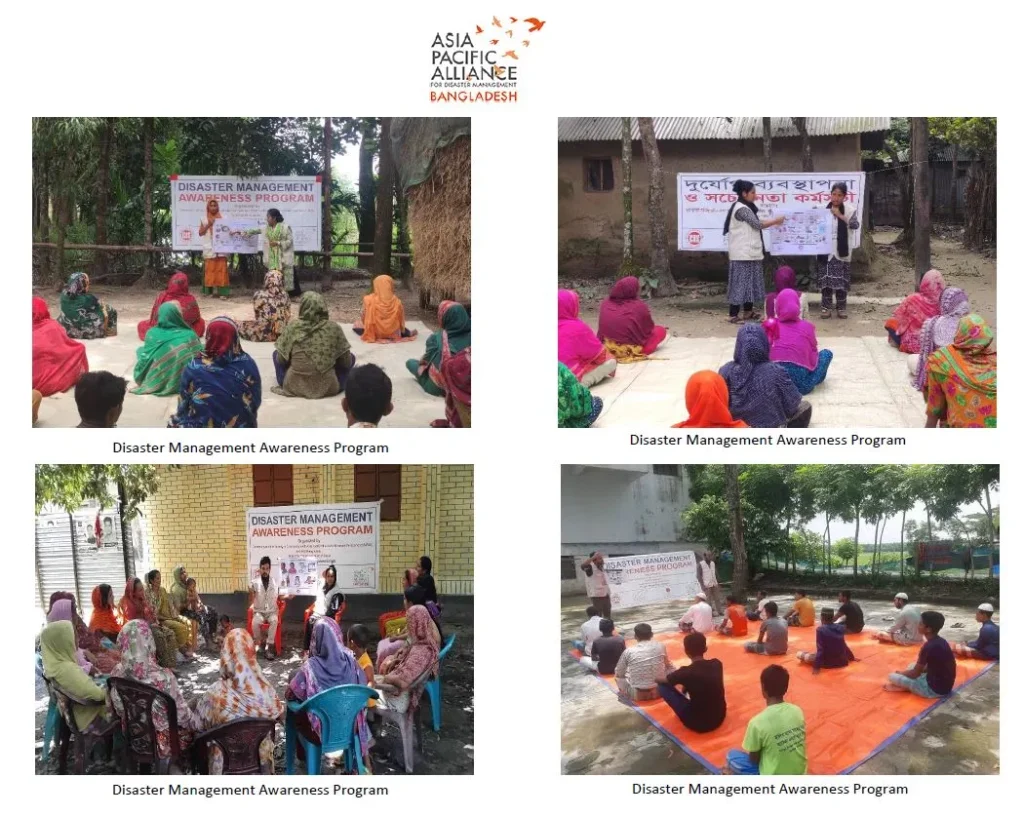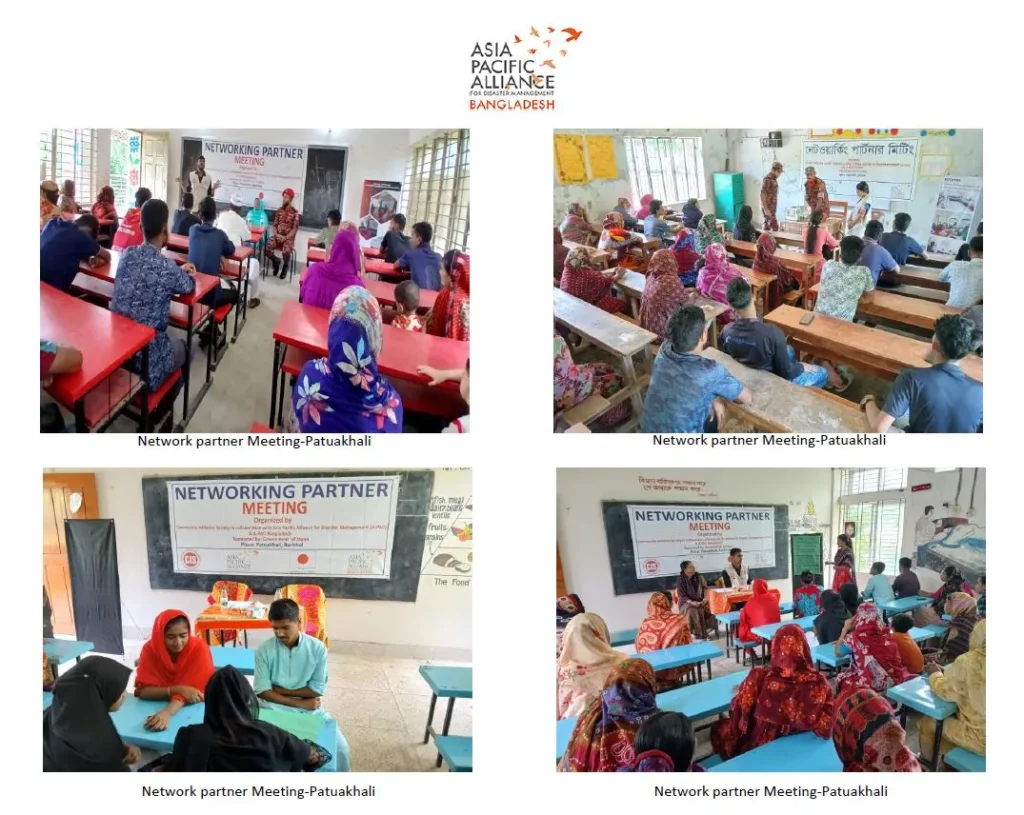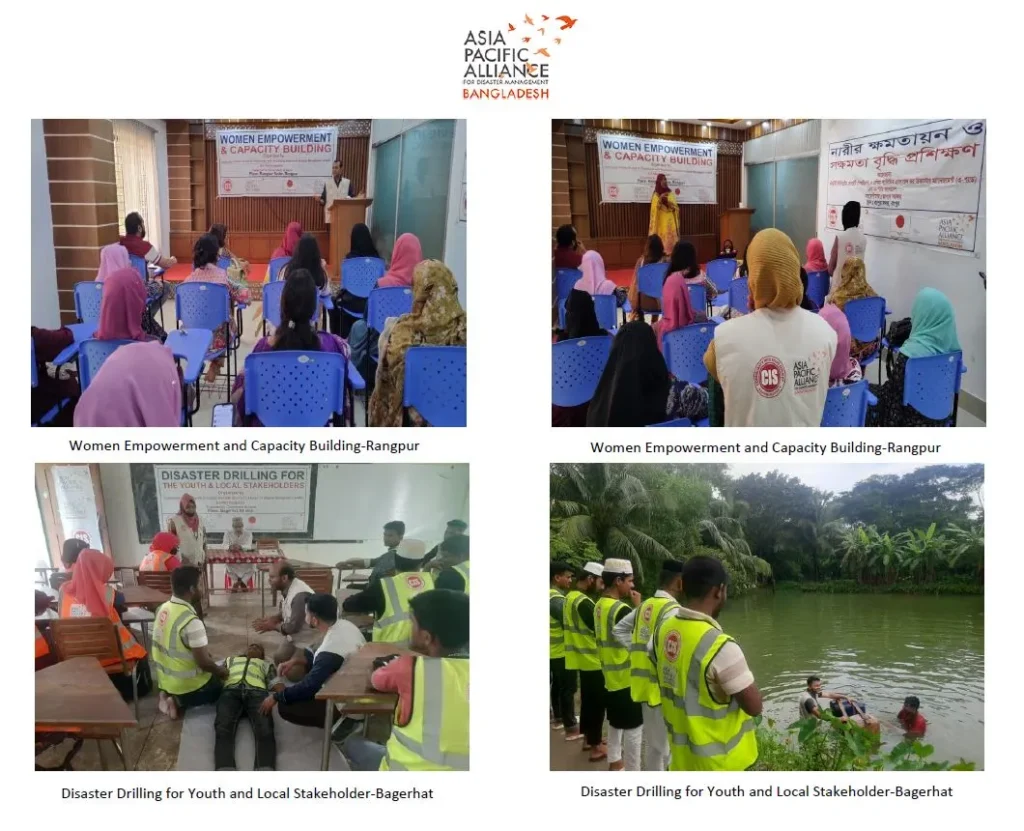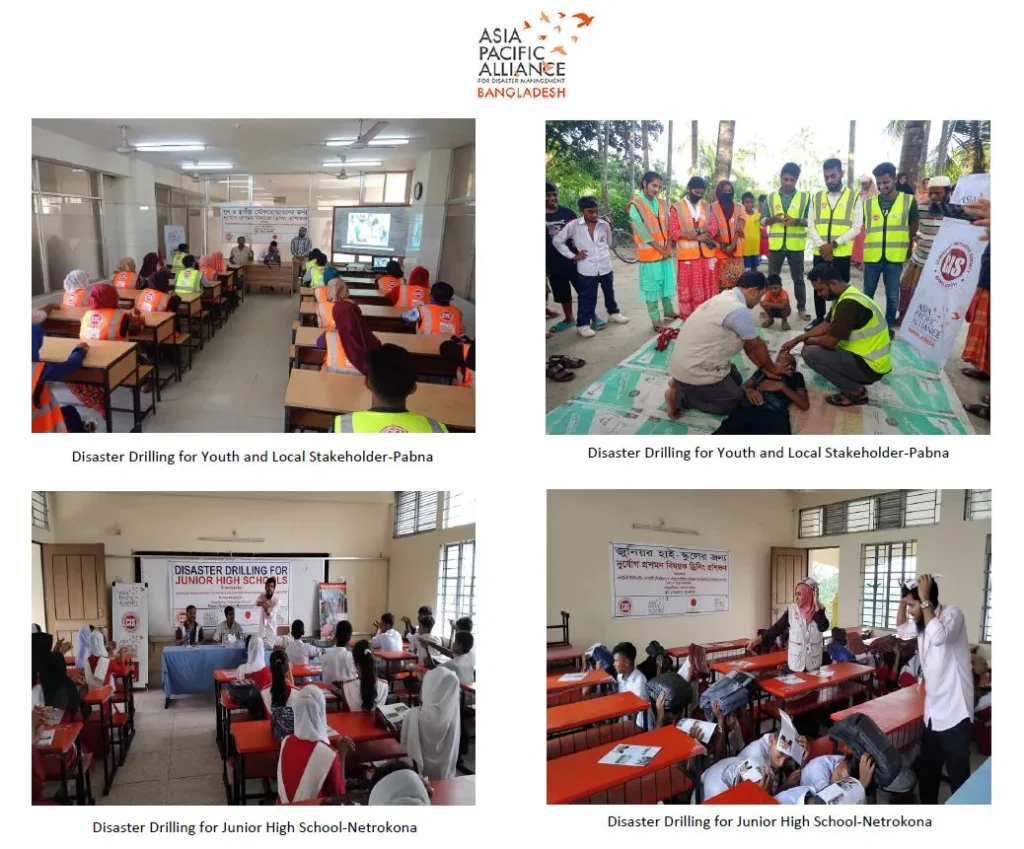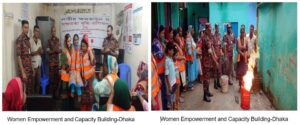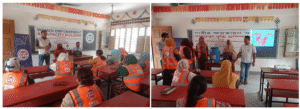Project Title: Strengthening Capacity for Sustainable Disaster Management Network by involving multi-sectoral platform Project Period: 17 January, 2024– 16 January, 2025 (12 month)
- Project Activities and Accomplishments
Bangladesh is ranking as one of the most disaster-prone countries. People in Bangladesh are often affected by water-related natural disasters, including floods, riverbank erosion and cyclones. In addition, recent rapid urbanization increases the risks for earthquake as well as man-made disasters. National Plan for Disaster Management (NPDM) 2021-2025 exemplified the strategic plan of the Government of Bangladesh in its Vision and the Mission of the Ministry of Disaster Management and Relief (MoDMR) between 2021 and 2025 towards building resilient nation. Bangladesh GOVT. has NPDM 2021-2025 has core goals for actions to save life, reduce economic losses in every disaster cycle stages which includes Disaster Risk Reduction (DRR), Humanitarian Response and Emergency Recovery Management. In Bangladesh most hazards impact: flood; cyclone and surge; tornado; earthquake; riverbank erosion; landslide; salinity intrusion; drought; tsunami; lightning; arsenic contamination; human-induced hazards and health hazards. The last hazard has potential for assuming significance because of the emerging risks in Bangladesh.
A-PAD Bangladesh started project from January 2023 and presently continue it 17 January 2024 to build up capacity on disaster management. It communicates with the different sectors like local community, community leaders, stakeholders, GOVT. officials continuing training on disaster management. To hold training program A-PAD Bangladesh staff organized small community meeting to sharing ideas on disaster and introduced them about A-PAD Bangladesh activity. A-PAD Bangladesh working 8 divisional areas.
There are 1 health workers in each divisions whose are doing home visit and aware the local community about basic disaster awareness. The health workers gave basic ideas about disaster management. A-PAD Bangladesh working at the rural areas. If there would be any directions or announcement from GOVT. or any disaster related news has been published the health workers delivered the message to the local community. Total 3,504 persons were benefited from A-PAD Bangladesh on August 2024.
A-PAD Bangladesh attended coordination meeting at the 8 divisions in Office of Deputy Commissioner. At that meeting different NGOs had joined and explained their activities. Besides this what will be the next activities of the GOVT. and NGOs were discussed at that meeting.
1. Strengthening of disaster risk reduction and disaster response system functions through the Emergency Disaster Management Coordination Center | ||
Activities | ( Outcome 1 ) The Emergency Disaster Management Coordination Center operated under this project will function as a disaster response base in each region, leading to the disaster risk reduction in the community and the strengthening of its disaster response system.: | Project Status: Achievements vs Outcome: If the activity is behind the schedule, please write the reason. |
1-1 Operation of Emergency Disaster Management Coordination Centers Target:Local communities 10 people×25 days×8 divisions×12 months =24,000 people | 【Indicators of Outcome】 1-1 The Emergency Disaster Management Coordination Center will be used for coordination meetings among partner organizations and relevant stakeholders during normal times, and will also serve as a center for health and public health guidance for the local residents. In the time of emergency, health services will be provided by emergency health workers. The Emergency Disaster Management Coordination Center will be used by 24,000 local residents (annual average) in the target area. (Indicator:number or visitors, record of services provided)
1-2 Through the Disaster Management Awareness Program, community residents will receive the latest disaster information and knowledge on how to respond to disasters, and people’s awareness of disaster prevention and response will be increased. (Indicator:Community disaster preparedness report) | Total 2,398 people visited to the Disaster Management Coordination Center to discuss about disaster preparedness and health related issues. Dhaka: 290 Persons Cox’s Bazar: 305 Persons Pabna: 288 Persons Bagerhat: 302 Persons Patuakhali: 320 Persons Habiganj: 310 Persons Rangpur: 305 Persons Netrokona: 278 Persons Total = 2,398 Persons |
1-2 Disaster Management Awareness Program Target:Local communities, Community leaders, Local NGOs, Private company workers, government officials 15 people × 8 divisions × 4 times ×12 months =5,760 people | A-PAD Bangladesh conducted Disaster Management Awareness programs at the 8 divisional areas where 500 persons have participated. Total 4 times training organized at each divisional areas. Dhaka:15 Participantsx 4 Sessons= 60 Participants Cox’s Bazar: 15 Participantsx 4 Sessons= 60+4=64 Participants Pabna: 15 Participantsx 4 Sessons= 60+2=62 Participants Bagerhat: 15 Participantsx 4 Sessons= 60+3=63 Participants Patuakhali: 15 Participantsx 4 Sessons= 60+2=62 Participants | |
|
| Habiganj: 15 Participantsx 4 Sessons= 60+3=63 Participants Rangpur: 15 Participantsx 4 Sessons= 60+2=62 Participants Netrokona: 15 Participants x 4 Sessons= 60+4=64 Participants |
2. Expansion of disaster management network to improve community vulnerability | ||
| (Outcome 2)The network of NPF will be expanded and the capacity of each region for disaster prevention and response will be strengthened. |
|
2-1 Network Partner Meeting Target : Local communities, Community leaders, Local NGO, Private Company Workers, Government officials 50 people × 5 villages × 8 divisions = 2,000 people | 【Indicator of Outcome】2-1 Strategies, mechanisms, and action plans for disaster reduction cooperation are developed in each region through discussions at network partner meetings, and a framework for disaster reduction cooperation is established. (Indicator:Strategic Plan) 2-2 MOUs signed with at least 5 new organizations, including private companies, in A-PAD Bangladesh NPF to expand the network (Indicator:number of new MOUs signed) 2-4 Resources possessed by A-PAD BGD partner organizations are provided in emergency disaster response, and play the role of that organization in times of emergency. (Indicator:List of resources such as supplies, human resources and donations provided by partner | As Patuakhali is situated along the coast, the region faces the annual challenge of natural disasters such as cyclones, floods, and tornadoes. Galachipa, located on the bank of the Ramnabad in Patuakhali District, is characterized by numerous rivers and canals. The area’s major challenges include cyclones, tidal waves, water scarcity, floods, and river erosion.
The networking partner meeting was organized in 5 places in Galachipa . The meeting was conducted at 5 villages where different contents had been discussed so that people from the local community, community leader, GOVT. officials and stakeholders focused on different sectors of disaster management. Total 262 participants joined the Network Partner Meetings.
17-08-2024, Middle Atkhali , Total Participants 50+2= 52 Participants 24-08-2024, Pankhali, Total Participants 50+3=53 Participants 25-08-2024, Chiknikandi, Total Participants 50+2= 52 Participants |
| organizations for emergency disaster response) | 29-08-2024, Atkhali, Total Participants 50+4=54 Participants 31-08-2024, Hogolbunia, Total Participants 50+1= 51 Participants Community Initiative Society (CIS) and the Asia Pacific Alliance (A-PAD) have joined forces to implement a comprehensive capacity-building project aimed at establishing and managing a sustainable multisector platform for disaster management in Bangladesh. As part of this initiative, CIS organized a 5-day networking partner meeting across five villages in Galachipa, with a total of 500 participants. This diverse group included representatives from various organizations, local communities, community leaders, local NGOs, private organizations, and government officials. The primary focus of the training program was to develop a robust emergency response platform specifically tailored for handling disasters in Patuakhali, while also enhancing the overall disaster response capacity at the community level during and after such calamities. It is essential to recognize that the coastal area serves as an interface between land and sea, encompassing both dry land and submerged areas influenced by marine characteristics such as tides, sea breezes, and saltwater infiltration. The majority of inhabitants in these coastal areas rely on fishing as their primary livelihood. Bangladesh Fire service department was also present there and discussed about fire incidents. There was also discussion on emergency medical support. There was also discussion on Cyclone preparedness and recent flood of Bangladesh. Participant were aware of cyclone preparedness activity and they are more interested to build a safer community. |
2-2 Disaster Preparedness Campaigns Target:Partner organizations and local communities 50 people × 2 times × 8 divisions = 800 people |
|
|
2-3 Network Partners Capacity Strengthening (DRR) Target : Partner organizations 20 people × 2 organizations × 2 times × 8 divisions = 640 people | A-PAD Bangladesh organized Network Partner Capacity Strengthening DRR at 2 divisional areas Cox’s Bazar anad Dhaka. 10-11 August 2024, Cox’s Bazar, Total Participants 40+1= 41 Participants 28-29 August 2024, Dhaka, Total Participants 40+3= 43 Participants There was a comprehensive and impactful disaster risk reduction training session conducted by CIS Cox’s Bazar named Networking Partners Capacity Strengthening (DRR) at Monupara Primary School and Save The Children NGO Auditorium Khurushkul Union, Cox’s Bazar Sadar. The training was attended by participants from different organizations and focused on disaster management and risk reduction measures. The training spanned two days and covered various important topics such as disaster mitigation, cyclone preparedness, landslide, Dengue Fever, and Fire Accident. It’s great to see that the participants were familiarized with disaster management terminologies, concepts, and the history and disaster risk profile of different contexts. It’s evident that the training aimed to enhance the capacity of individuals and organizations to respond to disasters effectively. The future goal of the training to |
|
| coordinate the work of actors at the local level, private organizations, and stakeholders is commendable, as it shows a strategic approach towards disaster risk reduction and management. Overall, it seems like a productive and informative training session that will undoubtedly contribute to building a more resilient community in Cox’s Bazar.
It’s important to recognize the impact of disasters, which can result in widespread human, material, and economic or environmental loss that exceeds the affected community or society’s ability to cope using its own resources. With natural and man-made disasters, Bangladesh faces a range of challenges including political issues which is manmade disaster others disasters such as floods, cyclones, riverbank erosion, and other issues. In urban areas, inadequate infrastructure and services can exacerbate the effects of natural hazards, turning them into disasters. For instance, poor solid waste management can lead to flooding due to blockage of storm water and sewage networks. It’s commendable that CIS organized a 2-day training program on Networking partners Capacity Strengthening DRR, with participation from from two NGOs,who work activcely on disaster management. The training covered important topics such as food and nutrition needs in emergencies, emphasizing the importance of proper food supply during disasters to prevent illness and death, especially among vulnerable populations. Additionally, discussions on household food security shed light on the crucial access to safe and nutritious food during emergencies. On the second day, the training delved into stress management, recognizing |
|
| the wide spectrum of techniques and psychotherapies aimed at controlling a person’s level of stress, particularly for emergency responders who face intense workloads and emotional challenges. This training was fruitful as recent Bangladesh face the histrocial flood situation so the participant can use their knowledge for emergency flood response. Overall, it’s evident that the training program addressed crucial aspects of disaster response and management, equipping participants with valuable knowledge and skills to better respond to emergencies in their communities. |
2-4 Seminar for Developing New Disaster Prevention Solutions Target : NGO, Disaster prevention related government organizations, Private sector personnels 30 people ( 2days ) × 8 divisions × 2 times = 480 people | The Disaster Prevention Solutions Seminar held in Habiganj on 13 and 14 August 2024 was organized by the Community Initiative Society (CIS) as a response to the growing vulnerabilities faced by communities in the region. Habiganj, located in the northeastern part of Bangladesh, is particularly prone to natural disasters such as floods, lightning strikes, and riverbank erosion, which have been exacerbated by climate change and environmental degradation.
13-14 August 2024, Habiganj, Total Participants 40+3= 43 Participants
In recent years, Habiganj has faced significant challenges posed by natural disasters. The area is prone to various calamities such as floods, lightning, and riverbank erosions, which often result in loss of lives, damage to property, and disruption of livelihoods. These disasters not only impact the immediate well-being of the inhabitants but also hinder the overall socio-economic development of the |
|
| region.Recognizing the urgent need for innovative approaches to mitigate the adverse effects of disasters, CIS Habiganj took the initiative to organize a seminar focused on developing new disaster prevention solutions.
The seminar was conceived to address these challenges by bringing together local stakeholders, including community leaders, government officials, NGOs, and disaster management experts. Recognizing that traditional disaster response methods were insufficient, CIS aimed to shift the focus towards prevention and preparedness, with a special emphasis on building local capacity and enhancing community resilience.
Key topics of the seminar included the implementation of early warning systems tailored to local needs, community- based disaster preparedness strategies that empower residents, and sustainable infrastructure development to mitigate disaster risks. The seminar also provided a platform for the exchange of innovative ideas and best practices, fostering a collaborative approach to disaster prevention.
Overall, the seminar was part of CIS’s ongoing efforts to strengthen disaster management capabilities in Habiganj, ensuring that the region’s communities are better equipped to handle the complex challenges posed by natural disasters. |
2-5 International Symposium on DRR
Target : Government, |
|
Local government, private company, NOG, partner organization, representative of A-PAD member countries, etc. 200 people |
|
|
3. Practical training to improve resilience of local communities | ||
| ( Outcome 3 ) Contribute to improving the disaster resilience of local communities through practical training. |
|
3-1 Disaster response capacity building of local community level in Health and hygiene field | 【Indicator of Outcome】 3-1 a) Establish networks of community leaders who can lead disaster response and emergency health response in all districts of Bangladesh. (Indicator:Number and the List of community leaders for disaster response/emergency health in each 8 districts.)
b) Networks of human resources with the skills and know-how to respond to health emergencies will be established in all districts of Bangladesh to provide health services to the local residents in times of emergency. (Indicator:Data of NGO health personals who can respond in emergency. Number of residents who received the services in the |
|
3-1 a) Workshop on Disaster Management and Emergency Health Response
Target : Local residents, Community leaders, Local NGO workers 25 people ( 2 days ) × 8 divisions × 2 times = 400 people | A-PAD Bangladesh organized Workshop on Disaster Management and Emergency Health Response at Netrokona.
11-12 August 2024, Netrokona, Total Participants 25+2=27 Participants Netrokona, a low-lying deltaic area prone to annual monsoon floods, recently faced one of its worst floods in recent times. Beginning in June and July, heavy rains caused rivers to breach their banks, inundating vast areas across multiple districts. The floodwaters submerged homes, agricultural lands, and infrastructure, disrupting the lives of millions of people. The floods caused extensive damage to homes, infrastructure, and livelihoods, exacerbating existing vulnerabilities in many communities. Immediate | |
| cases of activities during emergency disaster in each 8 districts.)
3-2 a) Disaster preparedness training and drills will be documented in a manual, and women, youth groups, and local stakeholders who participate in the drills will be granted certificates of completion and work as disaster volunteer teams during actual disasters. (Indicator:Drilling Manual, Cases of activities in emergency disaster response)
b) Disaster drills at junior high schools will be documented in a manual so that students who participate in the drills will have the skills to take appropriate action in the event of a disaster. (Indicator:Drilling Manual, Report of emergency disaster response) | humanitarian assistance is required to address the urgent needs of the affected population. The focus of the Workshop on Disaster Management & Emergency Health Response was to build capacity for emergency response regarding floods. CIS conducted a workshop program in Barhatta, Netrakona on 11th and 12th August 2024. During the workshop, Md. Rabiul Hasan Molla, Medical Officer in Barhatta, emphasized the recent flood situation in Netrokona district areas, where over 100 Family have been affected, with many displaced from their homes. Access to safe drinking water and sanitation facilities is severely compromised, increasing the risk of waterborne diseases. On the second day, Beauty Rani Debi, Head Teacher, noted that access to remote and flood- affected areas remains a challenge due to damaged infrastructure and ongoing rainfall. Funding constraints also limit the scale and scope of humanitarian assistance, necessitating increased support from international donors and partners. It is important for people to be aware of protecting themselves from heat stroke. Access to remote and flood-affected areas remains a challenge due to damaged infrastructure and ongoing rainfall. Funding constraints also limit the scale and scope of humanitarian assistance, necessitating increased support from NGOs and government organizations. |
3-1 b) Training of Local Health Workers on Disaster Health Activities | 3 days training program organized in Dhaka where 25 participants joined in the training workshop.
18-20 August 2024, Dhaka, Total Participants 25+2=27 Participants |
Target : Health workers |
|
|
who belong to local NGOs | Dhaka, the most populated city in Bangladesh, was the focus | |
or civil organizations | of a training workshop aimed at enhancing capacity for | |
20 people ( 3 days ) × 8 divisions = 160 people | emergency health response during and after a disaster. The workshop was attended by a total of 20 participants from various organizations including NGOs, private organizations, | |
| and health workers at the union level from Dhaka. A disaster | |
| is defined as an event, typically sudden, that causes damage, | |
| ecological disruption, loss of human life, deterioration of | |
| health and health services, and exceeds the capacity of the | |
| affected community to manage without outside assistance. It | |
| is an emergency of such severity and magnitude that routine | |
| procedures and resources are insufficient to effectively | |
| manage the resultant combination of disaster prevention | |
| and preparedness, injuries, illnesses, and property damage. | |
| Furthermore, a disaster is considered to be an event in which | |
| a society or community experiences acute deprivation of | |
| food and other basic necessities due to natural and man- | |
| made calamities to an extent that disrupts the normal | |
| functioning of the society or community, rendering it unable | |
| to subsist without outside intervention. | |
3-2 Strengthening disaster |
| |
response capacities of | ||
local communities | ||
through disaster | ||
drilling training | ||
3-2 a) | A-PAD Bangladesh organized Women Empowerment and | |
Women Empowerment and | Capacity Building Drilling in Rangpur, where in total 25 | |
Capacity Building | participants joined. |
Target : Women’s groups in target villages 20 people ( 2 days ) × 8 divisions × 2 times = 320 people |
| 27-28 August 2024, Rangpur, Total Participants 20+5= 25 Participants
The Rangpur district in Bangladesh is prone to disasters, with women being particularly vulnerable. Due to their limited access to resources and support networks, women often struggle to cope with the aftermath of disasters, leading to higher mortality rates among women compared to men. As climate change continues to impact the region, more women in Bangladesh will be affected. To address these challenges, CIS has focused on disaster awareness and prevention among women in Rangpur. The program aims to increase women’s knowledge of disaster risks and empower them to take an active role in preparing for and responding to disasters. The program provides training and capacity building activities to women in Rangpur on topics such as disaster awareness, emergency response, and risk reduction. This includes training on how to prepare for disasters, stay safe during disasters, and seek assistance afterward. Involving women in disaster planning creates resilience, as they can help identify risks not understood by male planners and build security for their families. By promoting disaster awareness and preparedness among women in Rangpur, CIS is helping to build resilience and reduce the impact of disasters on vulnerable communities. The program is part of CIS’s broader efforts to promote women’s empowerment and capacity building training, reflecting a commitment to creating a more equitable and sustainable society in Rangpur. CIS organized a two-day event to empower and build the capacity of women, aiming to enhance their skills and enable them to assume |
|
| leadership roles and participate in decision-making processes. The program’s participants are women in the Rangpur community, particularly those vulnerable to disasters due to their social and economic status. The event included workshops, interactive sessions, group discussions, role-playing exercises, and practical demonstrations. Workshops covered topics such as leadership development, communication skills, entrepreneurship, financial literacy, and self-confidence building. Interactive sessions and group discussions encouraged active participation and provided a platform for participants to share experiences and build networks. The program aims to empower women in the Rangpur community, promote women’s leadership, and facilitate their active participation in decision-making processes. |
3-2 b) Disaster Drilling for the Youth and Local Stakeholders Target:Youth in the local private and civic sector 45 people ( 2 days ) × 8 divisions × 2 times = 720 people | A-PAD Bangladesh organized drilling session organazied in Bagerhat total 95 participants joined.
28-29 August 2024, Bagerhat, Total Participants 45+2= 47 Participants 14-15 August 2024, Pabna, Total Participants 45+3=48 participants
The disaster drill program at Bagerhat involved the participation of youth and stakeholders. During the drill, there was a discussion about the types of disasters in Bangladesh and the necessary steps to be taken. The participants also discussed the use of local materials during disaster situations. The Cyclone Preparedness Programme |
|
| (CPP) facilitated the mock drill program, demonstrating what to do during cyclones, landslides, and floods. They also covered topics such as flood preparedness, including rules for storing dry food, making stoves during floods, ensuring safe drinking water, and guidelines for fire safety. |
3-2 c) Disaster Drilling for Junior High Schools Target:School Children 40 people ( 2 days ) × 8 divisions × 2 times = 640 people | School based drilling program organized in Netrokona 43 participants joined.
27-28 August 2024, Netrokona, Total Participants 40+3=43 participants
Netrakona district is one of the disaster-prone areas in Bangladesh. Due to its geographic location and weather conditions, cyclones, tidal floods, erratic rainfall, cold waves, arsenic contamination, and tornadoes are common occurrences in this area. The focus of the drilling program was to build capacity for emergency response during and after disasters and to create a safer environment, recognizing that children are the future of the world. A drilling program was conducted by CIS for Junior High school students in Barhatta, Netrakona on August 27th and 28th, 2024, spanning two days. On the first day of the meeting, Md. Kader Mia, UP Member, was present as the Chief Guest. He emphasized the crucial role of CIS and community volunteers in natural disaster management, highlighting that such demonstrations by volunteers can save lives and livelihoods in the event of a disaster. Md. Musahidur Rahman, the Head Teacher of Abbasia High School, commended Bangladesh’s progress in disaster management and expressed hope that |
|
| the exercise would help local people know what to do before |
a disaster, as well as signaling ongoing support for Barhatta | ||
Upazila. Md. Zahirul Haq, the Station Master of FSCD, | ||
highlighted that such activities would help prepare local | ||
people for disasters and conveyed his gratitude to the CIS | ||
team for organizing the training. He also expressed his belief | ||
that local people, as well as students, would be able to | ||
protect their lives and property during disasters by learning | ||
from the event. It is notable that CIS, in collaboration with | ||
FSCD, facilitated the mock drill program, which included | ||
demonstrations on what to do during cyclones, landslides, | ||
floods, and floods caused by heavy rains, as well as guidelines | ||
for keeping dry food, teaching children to swim, making | ||
stoves during floods, ensuring safe drinking water, and | ||
actions to take in case of a fire. | ||
3-3 Update website |
| |
contents as E-resources | ||
for Disaster | ||
Management | ||
| ||
| ||
| ||
| ||
| ||
| ||
| ||
| ||
| ||
|
4. Challenges
First week of the August, the political situation in Bangladesh became increasingly unstable, leading the government to declare a curfew. From the second week of August new GOVT. formed and activities continued as its scheduled.
Practice in collaboration with A-PAD Bangladesh Network Partners Please write good practice in collaboration with partner organizations
- Any contribution Funds Received and Grants Applied / Planned and Implemented Projects by CIS including Emergency Response
Please write Projects name and its fund resources
- Relationship with Bangladesh Government and Japanese Embassy Please write about Meeting with Government officials
